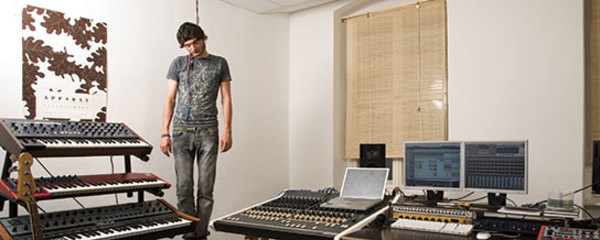Apparat In The Studio
“I can’t switch off in Berlin. I always feel like there’s work to be done,” […]
Apparat In The Studio
“I can’t switch off in Berlin. I always feel like there’s work to be done,” […]

“I can’t switch off in Berlin. I always feel like there’s work to be done,” admits Sascha Ring (a.k.a. Apparat) after a four-day production binge. “I completely forget what to do outside of the studio.” Not unlike the city in which he works, Ring’s own success has grown exponentially since his full-length Duplex appeared on Shitkatapult in 2003. Since then, collaborations with BPitch Control owner Ellen Allien resulted in this year’s Orchestra of Bubbles, an album praised on both sides of the dance/rock divide for finding middle ground between floor-focused techno and the quirky IDM of Apparat’s past. Yet despite all these notches in his production belt, Ring started out as a drummer, and he’s careful to envision the laptop as an instrument, especially when playing live. Here’s a look into the complex machinations behind techno’s newest tastemaker.
XLR8R: I heard you wrote your own Max/MSP tool for playing live. How does it work?
SR: The [patch] I wrote is very well assigned to the controller we use, so in the end it’s some kind of digital mixer with lots of effects for each channel. There’s not a lot of buttons on the mixer, but you can select channels and you have endless knobs, [so] you have a lot of control. I’ve used this thing for, like, four years, and now I can play it like a guitar.
You’ve been using the same patch for four years?
Yeah. I mean, it’s developing, but I don’t really have time to take it much further. But to be honest, I don’t really have many ideas of what I could change. Really, the only reason I did it was because there was no Ableton available when I started playing live. So I had to figure out a way to do what I needed, and I met Kit Clayton and all these guys and was completely stoked by the way they played. It was just one computer and one controller, and I was begging them to [show me how they did it]. Eventually they just gave me their patch, and I started learning how [Max] worked. But at some point, I decided… I don’t [expletive] understand this. So I had to program it myself. And it’s pretty messy.
Are you putting a lot of thought into what you’re doing on stage?
When Ellen and I first started talking about playing live, we wanted to do something special. It’s always kind of boring at festivals to watch people play just on laptops. But it turned out it wasn’t that easy. So we still have a lot of computer stuff going on, but we’re dancing and Ellen is singing. We’re trying to be entertaining! And if the set goes bad, or there’s six people there…after 10 beers…you start dancing again.
You don’t seem to get trapped staring at the screen when you play.
In the end, it’s important to look like you’re doing something. I designed my setup with a Kaoss Pad and a drum computer that I can tweak, which forces me to move around. But it’s funny… a key moment was when I played this show and I couldn’t put the mixer near me, [so] I had to keep running over to it. I realized it wasn’t really so bad because if you don’t have everything near you, you have to move.
When you’re back in the studio, do you prefer working with other people?
I’d been making music on my own for my whole life, and then Ellen came along and said, “Let’s work on stuff together,” and it was kind of hard. But I started recording different instruments and I had to deal with people. I had to learn how to speak about music. At some point, I just felt ready to do it, and I called Ellen again. I was really happy to leave the [solitary] nerd thing behind.
What’s your secret to finishing tracks?
It took me a long time to figure out when I was destroying something. I don’t think I do that anymore. You just learn to notice, very quickly, when you’re going down the wrong path. But for me, a second opinion is the main key for not destroying tracks. I have that now with Ellen, since we work on so much stuff together. And now, I feel kind of lonely in the studio without her.

